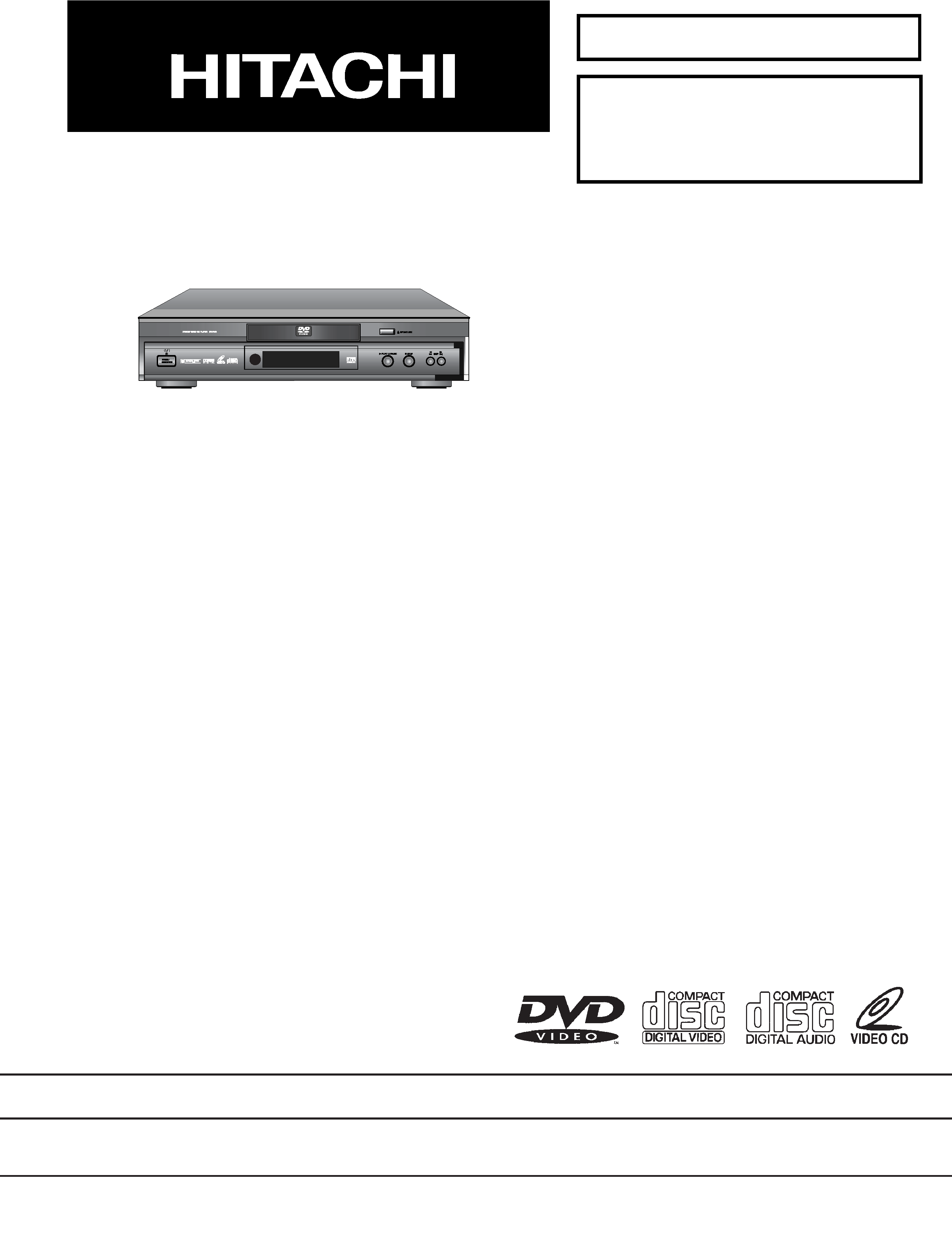
SM 9004
SPECIFICATIONS AND PARTS ARE SUBJECT TO CHANGE FOR IMPROVEMENT
DVD PLAYER
SERVICE MANUAL
April 2000
Digital Media Products Division, Tokai
DV-P305E
DV-P305E(UK)
1. Precautions
2. Reference Information
3. Product Specification
4. Operating Instructions
5. Disassembly and Reassembly
6. Circuit Descriptions
7. Troubleshooting
8. Exploded Views
9. Replacement Parts List
10. Block Diagram
11. PCB Diagrams
12. Wiring Diagram
13. Schematic Diagrams
CONTENTS

E1-1
1. Precautions
1-1 Safety Precautions
PRODUCT SAFETY NOTICE
Many electrical and mechanical parts have special
safetyrelated characteristics. These are often not
evident from visual inspection nor can the
protection afforded by them necessarily be obtained
by using replacement components rated for a higher
voltage, wattage, etc.
Replacement parts which have these special safety
characteristics are identified in this Service Manual.
Electrical components having such features are
identified by marking with a
on the schematics
and the parts list in this Service Manual. The use of
a substitute replacement component which does not
have the same safety characteristics as the HITACHI
recommended replacement one, shown in the parts
list in this Service Manual, may create shock, fire, or
other hazards. Product safety is continuously under
review and new instructions are issued from time to
time. For the latest information, always consult the
current HITACHI Service Manual. A subscription
to, or additional copies for, HITACHI Service
Manual may be obtained at a nominal charge from
HITACHI SALES CORPORATION.

Precautions
1-2 Servicing Precautions
CAUTION : Before servicing Instruments covered
by this service manual and its supplements, read and
follow the Safety Precautions section of this manual.
Note : If unforseen circument create conflict between
the following servicing precautions and any of the
safety precautions, always follow the safety
precautions. Remember: Safety First.
1-2-1 General Servicing Precautions
(1) a. Always unplug the instrument's AC power cord
from the AC power source before (1) re-moving
or reinstalling any component, circuit board,
module or any other instrument assembly, (2)
disconnecting any instrument electrical plug or
other electrical connection, (3) connecting a test
substitute in parallel with an electrolytic
capacitor in the instrument.
b. Do not defeat any plug/socket B+ voltage
interlocks with which instruments covered by
this service manual might be equipped.
c. Do not apply AC power to this instrument and
/or any of its electrical assemblies unless all
solid-state device heat sinks are correctly in-
stalled.
d. Always connect a test instrument's ground lead
to the instrument chassis ground before
connecting the test instrument positive lead.
Always remove the test instrument ground lead
last.
Note : Refer to the Safety Precautions section ground
lead last.
(2) The service precautions are indicated or printed on
the cabinet, chassis or components. When
servicing, follow the printed or indicated service
precautions and service materials.
(3) The components used in the unit have a specified
flame resistance and dielectric strength.
When replacing components, use components
which have the same ratings. Components i-
entified by shading, by(
) or by (
) in the circuit
diagram are important for safety or for the
characteristics of the unit. Always replace them
with the exact replacement components.
(4) An insulation tube or tape is sometimes used and
some components are raised above the printed
wiring board for safety. The internal wiring is
sometimes clamped to prevent contact with
heating components. Install such elements as they
were.
(5) After servicing, always check that the removed
screws, components, and wiring have been in-
stalled correctly and that the portion around the
serviced part has not been damaged and so on.
Further, check the insulation between the blades of
the attachment plug and accessible conductive
parts.
1-2-2 Insulation Checking Procedure
Disconnect the attachment plug from the AC outlet
and turn the power ON. Connect the insulation resi-
stance meter (500V) to the blades of the attachment
plug. The insulation resistance between each blade of
the attachment plug and accessible conductive
parts(see note) should be more than 1 Megohm.
Note : Accessible conductive parts include metal
panels, input terminals, earphone jacks, etc.
E1-2

Precautions
1-3 ESD Precautions
Electrostatically Sensitive Devices (ESD)
Some semiconductor (solid state) devices can be
damaged easily by static electricity.
Such components commonly are called Electrostati-
cally Sensitive Devices(ESD). Examples of typical ESD
devices are integrated circuits and some field-effect
transistors and semiconductor chip components. The
following techniques should be used to help reduce
the incidence of component damage caused by static
electricity.
(1) Immediately before handling any semiconductor
component or semiconductor-equipped assembly,
drain off any electrostatic charge on your body by
touching a known earth ground. Alternatively,
obtain and wear a commercially available
discharging wrist strap device, which should be
removed for potential shock reasons prior to
applying power to the unit under test.
(2) After removing an electrical assembly equipped
with ESD devices, place the assembly on a
conductive surface such as aluminum foil, to
prevent electrostatic charge buildup or exposure of
the assembly.
(3) Use only a grounded-tip soldering iron to solder
or unsolder ESD devices.
(4) Use only an anti-static solder removal devices.
Some solder removal devices not classified as
"anti-static" can generate electrical charges
sufficient to damage ESD devices.
(5) Do not use freon-propelled chemicals. These can
generate electrical charges sufficient to damage
ESD devices.
(6) Do not remove a replacement ESD device from its
protective package until immediately before your
are ready to install it.(Most replacement ESD
devices are packaged with leads electrically
shorted together by conductive foam, aluminum
foil or comparable conductive materials).
(7) Immediately before removing the protective ma-
terials from the leads of a replacement ESD device,
touch the protective material to the chassis or
circuit assembly into which the device will be
installed.
CAUTION : Be sure no power is applied to the ch-
assis or circuit, and observe all other safety
precautions.
(8) Minimize bodily motions when handling
unpackaged replacement ESD devices. (Otherwise
harmless motion such as the brushing together of
your clothes fabric or the lifting of your foot from a
carpeted floor can generate static electricity
sufficient to damage an ESD device).
E1-3

E1-4
Precautions
1-4 Handling the optical pick-up
The laser diode in the optical pick up may suffer
electrostatic breakdown because of potential static
electricity from clothing and your body.
The following method is recommended.
(1) Place a conductive sheet on the work bench (The
black sheet used for wrapping repair parts.)
(2) Place the set on the conductive sheet so that the
chassis is grounded to the sheet.
(3) Place your hands on the conductive sheet(This
gives them the same ground as the sheet.)
(4) Remove the optical pick up block
(5) Perform work on top of the conductive sheet. Be
careful not to let your clothes or any other static
sources to touch the unit.
·Be sure to put on a wrist strap grounded to the
sheet.
·Be sure to lay a conductive sheet made of copper etc.
Which is grounded to the table.
Fig.1-3
(6) Short the short terminal on the PCB, which is in-
side the Pick-Up ASS'Y, before replacing the Pick-
Up. (The short terminal is shorted when the Pick-
Up Ass'y is being lifted or moved.)
(7) After replacing the Pick-up, open the short
terminal on the PCB.
THE UNIT
WRIST-STRAP
FOR GROUNDING
1M
1M
CONDUCTIVE SHEET
